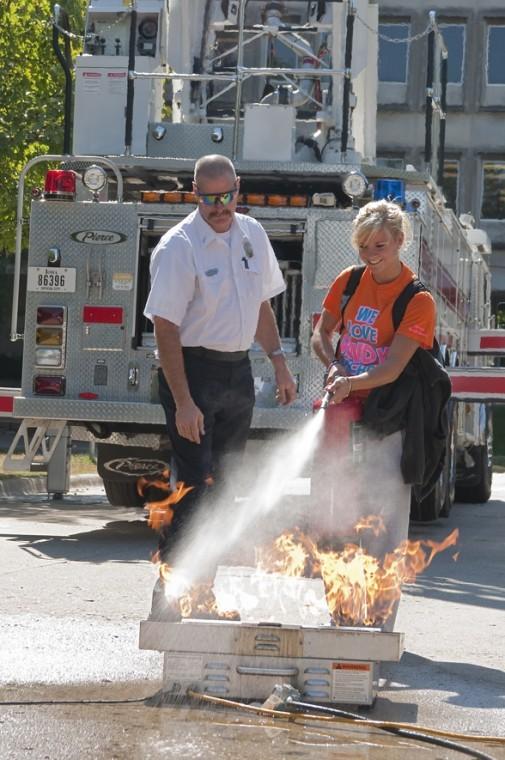Fire Prevention Week rounds out
Photo: Logan Gaedke/Iowa State Daily
Kelsey Eischeid, left, freshman in kinesiology and health, puts out a fire with instruction by Lt. Brian O’Loughlin of the Ames Fire Department on Friday, Sept. 17 near Kildee Hall.
October 7, 2010
Fire prevention is instilled in everyone from a young age.
From fire drills in school to the presence of Smokey Bear, many steps are taken to convey the importance of safety when it comes to dealings with fire.
In the last 150 years of Iowa State’s existence, there has not been one report of a fire-related death on campus. Every year the Ames Fire Department and ISU Department of Residence come together to help inform people of fire safety for Fire Prevention Week.
Fire prevention groups have been getting the word out about remaining alert and safe in terms of fire safety. Fire Prevention Week also helps young adults get involved with local schools and organizations to become acquainted with fire safety.
“Comfort is important and students want to graduate, therefore, here at the fire safety office we do our best to make sure students have nothing to worry about but their credentials for school,” said Peter Englin, director of the Department of Residence.
Fire Prevention Week began Monday and runs through Saturday. Students get the opportunity to volunteer to mentor teens about fire prevention.
Iowa State has implemented some important safety features. Fire prevention has excelled during the years, with ISU fire safety providing the school with the latest state of the art smoke alarms and increasing temperature detector systems all over campus.
Iowa State takes additional precautions regarding student safety, having the local fire department come once a month and inspect campus grounds and buildings for any fire hazards.
Iowa State also features additional safety features, such as updating sprinkler systems annually, placing fire extinguishers every 20 to 50 feet in every building on every floor, cracking down on policies, increasing security with ISU police and closely monitoring surveillance cameras around campus.
Getting the message to everyone about fire safety is not an easy task. The Department of Residence relies on the campus housing system to relay important information to students.
“Educating students through house meetings and bulletin board posts is the most important,” Englin said. “Planned fire drills are to plan your escape in case of a fire and random fire drills are practice, so students have nothing to worry about [in the event of an actual fire].”
Fire Prevention Week was brought to existence in memory of the Great Chicago Fire of 1871. The event was caused by a simple incident, when a cow knocked over a lantern, causing a fire that killed approximately 3,000 people and left 9,000 homeless and $200 million in damage. The event stresses the danger of fires and need for prevention.







